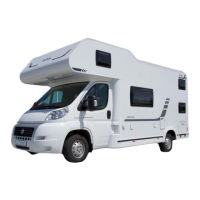03-6
3.5 Locking brake
facilities
The components of the brake system, especially
the overrun coupling, transmission and wheel
brakes have been checked in accordance with
the corresponding EU directives and may only
be used in the licensed combination.
If you alter or modify any components of the
brake facilities, the operation permission loses
its validity. Modications may only be made with
the manufacturer's permission.
Parking the carriage
When parking the carriage, the locking brake of
the camper must be activated.
To lock
• Pull the locking brake lever upward by the
handle
j
until it locks into place. The locking
brake lever is pressed into the nal position
by the gas pressure spring.
To release
• Push the hand brake forward to the starting
position.
1
When you park the camper after
reversing it, the hand brake must
be moved beyond the dead centre
position to its nal position in order to
ensure that it is fully effective.
Rapid-emergency brake
The rapid-emergency brake is combined with the
hand brake. If the camper is involuntarily discon-
nected from the base vehicle, the hand brake will
be tightened or moved beyond the dead centre
position by the traction force of the rapid-emer-
gency brake
k
. The hand brake will be emplo-
yed and the camper will do an emergency brake.
This prevents the camper from continuing to roll
without braking after it has been disconnected.
Before driving, the rapid-emergency
brake must be fastened to the base
vehicle.
2

